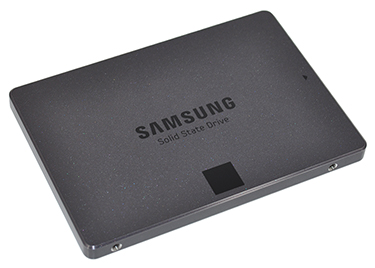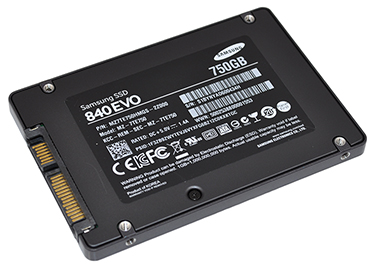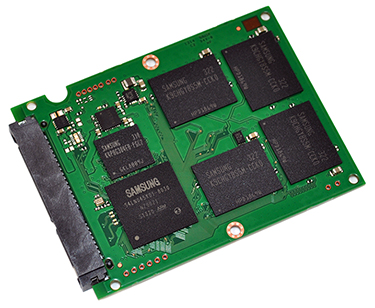Introduction
Samsung's been on a roll with its SSDs of late, producing one stellar offering after another, including the recently-unveiled 840 EVO. Armed with a TurboWrite cache, the company's latest drive is able to offer something few others have been able to achieve; high speeds in affordable, low-capacity models.
We've already seen the 120GB 840 EVO strut its stuff, but the capabilities of the smallest drive in the range aren't Samsung's only new developments. The 840 EVO also brings 128Gb die to the table, allowing the South Korean manufacturer to create SSDs with greater capacity.
The previous-generation 840 and 840 PRO were nice drives, but they topped out at 500GB and 512GB, respectively. This time around, the introduction of a 19nm, 128Gb die results in the 840 EVO being served up in spacious 750GB and 1TB capacities, putting Samsung's drive on a level playing field with Crucial's M500.
Here's how the 750GB 840 EVO shapes up internally. Compared to the 120GB drive, Samsung is using a larger PCB to house the extra chips, with the 750GB model carrying eight NAND packages, each equipped with half-a-dozen 128Gb die.
The same 400MHz, triple-core Samsung MEX processor is used to power each drive in the 840 EVO range, but the amount of accompanying DDR2 cache varies depending on capacity. We're looking at an entire gigabyte of cache on the 750GB drive (compared to 256MB on the 120GB model), and there's more memory set aside for TurboWrite, too.
TurboWrite, if you recall, increases the drive's write performance by configuring a portion of onboard NAND in a single-level-cell (SLC) mode to act as a write-exclusive cache. The drive is built using high-capacity triple-level-cell (TLC) memory, but Samsung uses a certain amount in this pseudo-SLC mode to take advantage of the higher write performance available to SLC flash.
The advantages of TurboWrite are most obvious in the smaller 120GB drive, where sequential write performance increases from 140MB/s with no cache to 410MB/s with TurboWrite in operation. The 750GB model on the test bench today sees a smaller increase, but a purported rise from 420MB/s to 520MB/s is still handy to have.
However, while Samsung has been able to narrow the performance gap between small- and large-capacity drives, let's not forget that the gap still exists. The 840 EVO's MEX processor makes use of a 32-channel design, meaning the 500GB, 750GB and 1TB models - which each carry a die count of 32, or more - are best positioned to saturate the full bandwidth available to Samsung's underlying architecture.
Samsung SSD 840 EVO Series |
||||||
|---|---|---|---|---|---|---|
| Model | 250GB |
500GB |
1TB |
|||
| Processor | Samsung 3-core MEX |
|||||
| NAND | 19nm Samsung Toggle DDR 2.0 NAND Flash Memory (400Mbps) |
|||||
| NAND Packages | 2 |
2 |
4 |
8 |
8 |
|
| Die per NAND Package | 4 |
8 |
8 |
6 |
8 |
|
| Total Number of Die | 8 |
16 |
32 |
48 |
64 |
|
| Total Drive Capacity | 128GB |
256GB |
512GB |
768GB |
1,024GB |
|
| TurboWrite Cache | 3GB |
3GB |
6GB |
9GB |
12GB |
|
| Onboard DDR2 Cache | 256MB |
512MB |
512MB |
1GB |
1GB |
|
| Interface | SATA 6Gb/s, compatible with SATA 3Gb/s and 1.5Gb/s |
|||||
| Sequential Read Speed | up to 540 MB/s |
up to 540 MB/s |
up to 540 MB/s |
up to 540 MB/s |
up to 540 MB/s |
|
| Sequential Write Speed | up to 410 MB/s |
up to 520 MB/s |
up to 520 MB/s |
up to 520 MB/s |
up to 520 MB/s |
|
| Random IOPs (4KB Reads, QD32) | up to 94,000 IOPs |
up to 97,000 IOPs |
up to 98,000 IOPs |
up to 98,000 IOPs |
up to 98,000 IOPs |
|
| Random IOPs (4KB Writes, QD32) | up to 35,000 IOPs |
up to 66,000 IOPs |
up to 90,000 IOPs |
up to 90,000 IOPs |
up to 90,000 IOPs |
|
| Dimensions (LxWxH) | 100 x 69.85 x 6.8 (mm) |
|||||
| Active Power Consumption | 0.1W Typical |
|||||
| Idle Power Consumption | 0.045W Typical |
|||||
| Life Expectancy | 1.5 million hours Mean Time Between Failures (MTBF) |
|||||
| Endurance | 72TB total bytes written (TBW), equal to 40GB per day for 5 years |
|||||
| Warranty | 3 Years |
|||||
| MSRP | Basic | |||||
| w/ Laptop Kit | N/A |
N/A |
N/A |
|||
| w/ Desktop Kit | N/A |
N/A |
N/A |
|||
| Cost per GB (Basic Model) | 72p |
60p |
58p |
55p |
51p |
|
There's the small matter of cost to consider, too. Sure, the 120GB drive looks a tempting sub-£100 upgrade, but on a cost-per-GB basis, perceived value increases as you go up in capacity; it's 72p-per-GB for the 120GB drive, compared to 55p-per-GB for the 750GB model. That's a sizeable gap, and if you've got the funds, it's worth remembering that you'll get more gigabytes for your pounds if you opt for a larger drive.
However, consumers seeking high solid-state capacity for the lowest possible cost should note that Crucial's rival M500 is, at the time of writing, even more competitive, with a 960GB M500 now available for £455 (47p-per-GB). Samsung's voluminous 840 EVO will need to have a performance edge if it's to stand out from the competition, so let's see how the 750GB drive stacks up.













